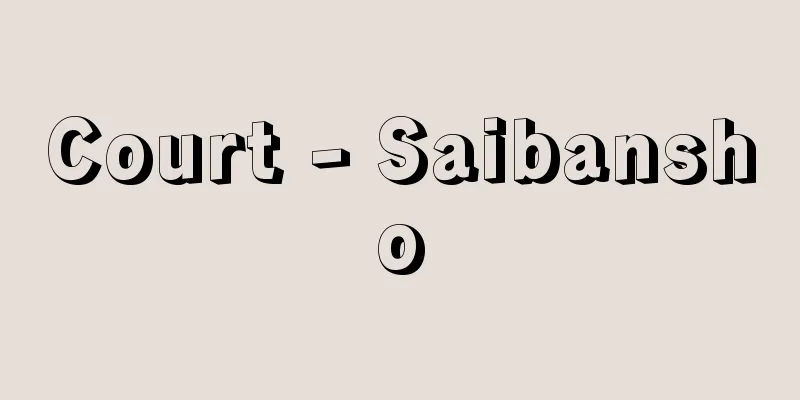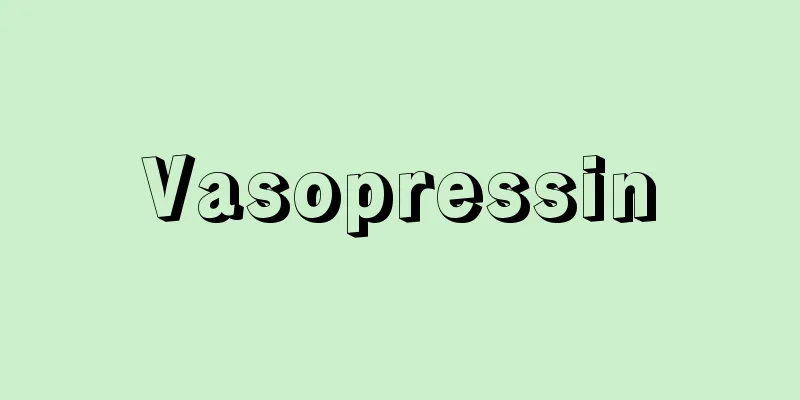Court - Saibansho

|
It refers to a state organ with judicial power or a judicial unit composed of one or more judges. The word "court" has multiple meanings. First, it is used to mean a court as a national organization, and is a unit of judicial administration. In this case, it can also mean a court as an agency that refers to a national organ in the form of a judges' conference, or as an office that includes staff other than judges who are its auxiliary organs. This can also include cases where the court's building is called a court. The word "court" in this sense is often used in the Court Act, and is called a court in the sense of national law. Secondly, it is a court that is an office that serves as a judicial body and is a unit that carries out trials, and there are single-judge courts consisting of one judge and collegial courts consisting of multiple judges. Since it is a judicial body, it is called a court in the sense of procedural law, and is often used in procedural law. Under the Constitution, judicial power belongs to the courts, and the courts are the Supreme Court and lower courts established as prescribed by law (Constitution, Article 76, Paragraph 1). It is not permitted to establish special courts or administrative courts other than those (Constitution, Article 76, Paragraph 2). [Moriichi Taguchi] kindsThere are the Supreme Court and lower courts, the latter of which are the High Court, District Court, Family Court and Summary Court (Court Act, Article 2, Paragraph 1). The establishment, abolition and jurisdiction of the lower courts are to be determined by a separate law (Court Act, Article 2, Paragraph 2), and the "Law Concerning the Establishment and Jurisdiction of Lower Courts" (Law No. 63 of 1947) is one such law. Japan has a three-tiered system, so there is a distinction between first-instance courts, second-instance courts and third-instance courts. In addition, there is a distinction between sentencing courts, decision courts and ordering courts depending on the type of trial. The Law on Criminal Trials with Lay Judges (Law No. 63 of 2004), which came into force in 2009, established a court system with a panel of lay judges and judges (called constituting judges) for certain cases. In Japan, a type of jury trial was conducted from October 1, 1928 (Showa 3) under the Jury Law (Law No. 50 of April 18, 1923) until the enforcement of the Jury Law was suspended on April 1, 1943, but it did not become established. In the newly established lay judge system, lay judges selected from among the general public are involved in determining facts, applying laws and regulations, and determining sentences in consultation with the judges (Article 6, Paragraphs 1 and 3 of the Law on Criminal Trials with Lay Judges), which is significantly different from the jury system in which the jury alone determines guilt or innocence. [Ichiro Uchida and Morikazu Taguchi] [References] | | | | | |Completed in April 1974. It has five floors above ground and two below, and the exterior walls of the reinforced concrete structure are covered with granite. Chiyoda-ku, Tokyo ©Yutaka Sakano "> supreme court Source: Shogakukan Encyclopedia Nipponica About Encyclopedia Nipponica Information | Legend |
|
司法権(裁判権)を有する国家機関、または、一人もしくは複数の裁判官により構成される裁判機関の単位をいう。 裁判所という語は、多義的である。第一には、国の組織としての裁判所の意味で用いられ、司法行政上の単位となる。この場合にも、さらに、裁判官会議という形での国家機関をさす官庁としての裁判所を意味する場合と、その補助機関である裁判官以外の職員を含めた官署としての裁判所を意味する場合とがある。裁判所の庁舎を裁判所とよぶ場合もこれに含めることができる。このような意味での裁判所の語は、裁判所法で用いられることが多く、国法上の意味の裁判所とよばれている。第二には、官署としての裁判所において、裁判機関として審判を行う単位としての裁判所であり、一人の裁判官からなる一人制の裁判所と複数の裁判官で構成される合議制の裁判所がある。裁判機関としての裁判所であるから、訴訟法上の意味の裁判所とよばれ、訴訟法で用いられることが多い。憲法上、司法権は裁判所に属しており、その裁判所は、最高裁判所および法律の定めるところにより設置する下級裁判所とされている(憲法76条1項)。それ以外に特別裁判所あるいは行政裁判所を設けることは認められていない(憲法76条2項)。 [田口守一] 種類最高裁判所と下級裁判所があり、後者は、高等裁判所、地方裁判所、家庭裁判所および簡易裁判所とする(裁判所法2条1項)。下級裁判所の設立、廃止および管轄区域は、別に法律でこれを定めることになっていて(同法2条2項)、その法律として、「下級裁判所の設立及び管轄区域に関する法律」(昭和22年法律第63号)が制定されている。日本では三審級の制度をとっているので、一審裁判所、二審裁判所、三審裁判所の区別がある。また、裁判の種類に応じて、判決裁判所、決定裁判所、命令裁判所が区別される。 2009年(平成21)より実施された「裁判員の参加する刑事裁判に関する法律」(平成16年法律第63号)により、一定の対象事件について、裁判員と裁判官(構成裁判官という)との合議体による裁判所が創設された。日本でも陪審法(大正12年4月18日法律第50号)により、1928年(昭和3)10月1日から1943年4月1日に陪審法の施行が停止されるまで、一種の陪審裁判が行われたことがあるが、定着するに至らなかった。新たに創設された裁判員制度は、国民のなかから選任された裁判員が、裁判官との合議により、事実の認定、法令の適用および刑の量定に関与するものであり(裁判員の参加する刑事裁判に関する法律6条1項・3項)、陪審員のみで有罪無罪の判断を行う陪審制度とは大きく異なる。 [内田一郎・田口守一] [参照項目] | | | | | |1974年(昭和49)4月完成。地上5階、地下2階建てで、鉄筋コンクリート造の外壁を花崗岩で覆ってある。東京都千代田区©Yutaka Sakano"> 最高裁判所 出典 小学館 日本大百科全書(ニッポニカ)日本大百科全書(ニッポニカ)について 情報 | 凡例 |
<<: Court summary - Saibanshosho
>>: Jurisdiction - Jurisdiction
Recommend
Centrifugal brake
...Anti-skid brakes are said to have first been u...
《Alamo》
… [decline] It is said that the rise and fall of ...
Acute renal parenchymal failure
…For this reason, renal failure is considered to ...
Laws of the Sea of Oléron (English: Laws of the Sea of Oléron)
It is a collection of decisions of the Maritime Co...
Ganj Dareh (English spelling) GanjDareh
...The monistic theory, which holds that the olde...
Six Boundaries - Rokkyo
〘Noun〙 A Buddhist term. The six consciousnesses (r...
The Great Society
...So in 1964, a large tax cut was implemented th...
Masatsugu Ando
Born: September 13, 1878 in Saitama [Died] Novembe...
Prayer Book
…It is an offshoot of Irish, but the initial stat...
Women's liberation movement
A social movement that seeks equal rights for wome...
Comb-shaped small window - Kushigata no komado
…The tableware used for the meals served at the O...
Katana slugfish - Katana slugfish
...The reproductive season is from June to July. ...
Galeatus spinifrons (English spelling)
...Some species transmit plant pathogens such as ...
Deutzia umbellata - Deutzia umbellata
…A deciduous tree of the Rosaceae family cultivat...
Casuarina equisetifolia (English spelling)
… [Okamoto Motoji]. … *Some of the terminology th...









